目录
前言
今天学习一种算法问题,也就是我们常见的迷宫问题,本期我们通过前面学习过的数据结构---栈来去完美的解决这个问题,下面看问题!
迷宫问题
给定一个迷宫,指明起点和终点,找出从起点出发到终点的有效可行路径,就是迷宫问题(maze problem)。
迷宫可以以二维数组来存储表示。0表示通路,1表示障碍。注意这里规定移动可以从上、下、左、右四方方向移动
int maze[6][6] = {
{1,1,1,1,1,1},
{1,0,0,1,1,1},
{1,0,0,0,0,0},
{1,0,1,1,1,0},
{1,0,0,0,0,1},
{1,1,1,1,1,1}
};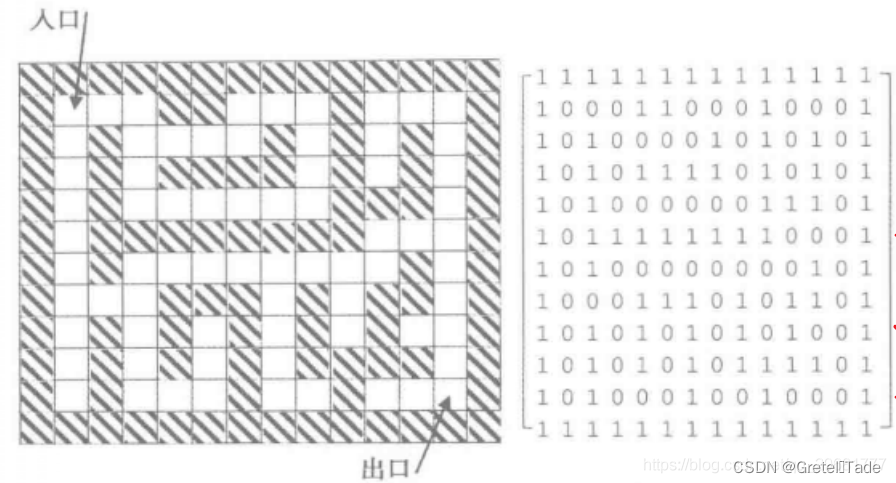
算法思路
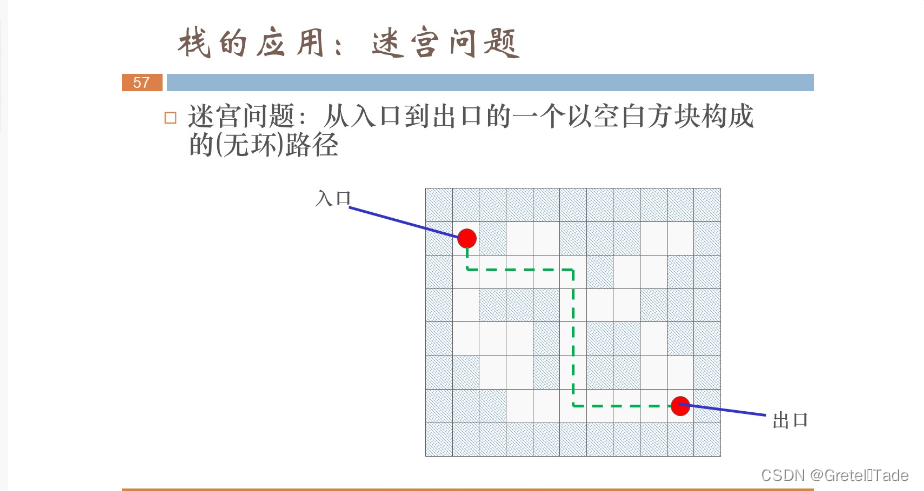
1.栈的使用方法
迷宫问题,二维数组外围全是1的围墙,在里面规定一个起始地点和终点,这里我们要想找到起点到终点的路径,就需要一个数据结构去储存这个路径,这里可以用到栈的后进先出的特点,每次进入到一个可通过的点,就把这个点存入到栈当中,直到遇到了死胡同的时候,就回到上一个点,这时候就进行出栈的操作,然后走另外一条路,直到走到终点为止。
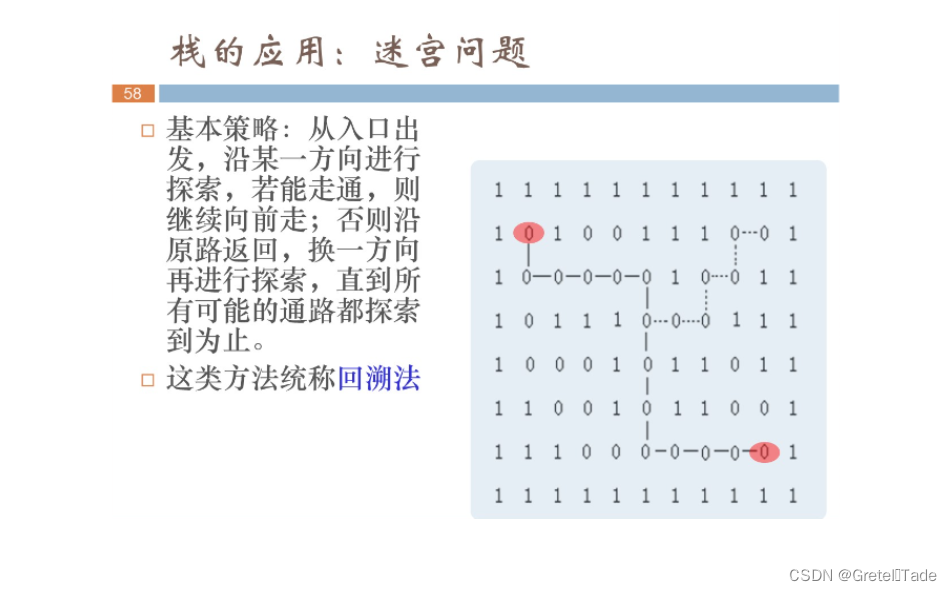
 2.方向的定义
2.方向的定义
了解了栈的使用方法,那这里就要去定义移动的方向了,当走到某一个点的时候就要考虑优先往那边走,这时候可以根据迷宫的入口和出口大致方向去决定优先方向,这里的迷宫入口在出口的西北方向,那么优先的方向我依次为东、南、西、北,也就是说优先往东走,其次是南、西、北。方向的移动可以根据当前坐标进行上下左右的移动,只需要去定义一个方向数组,然后加上这个数组的方向即可。
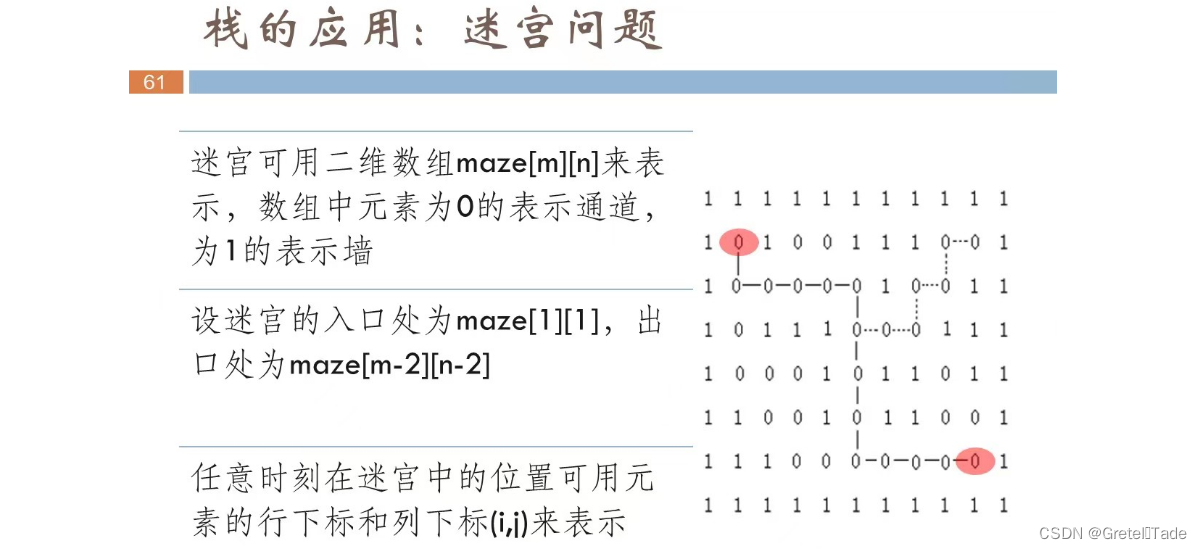
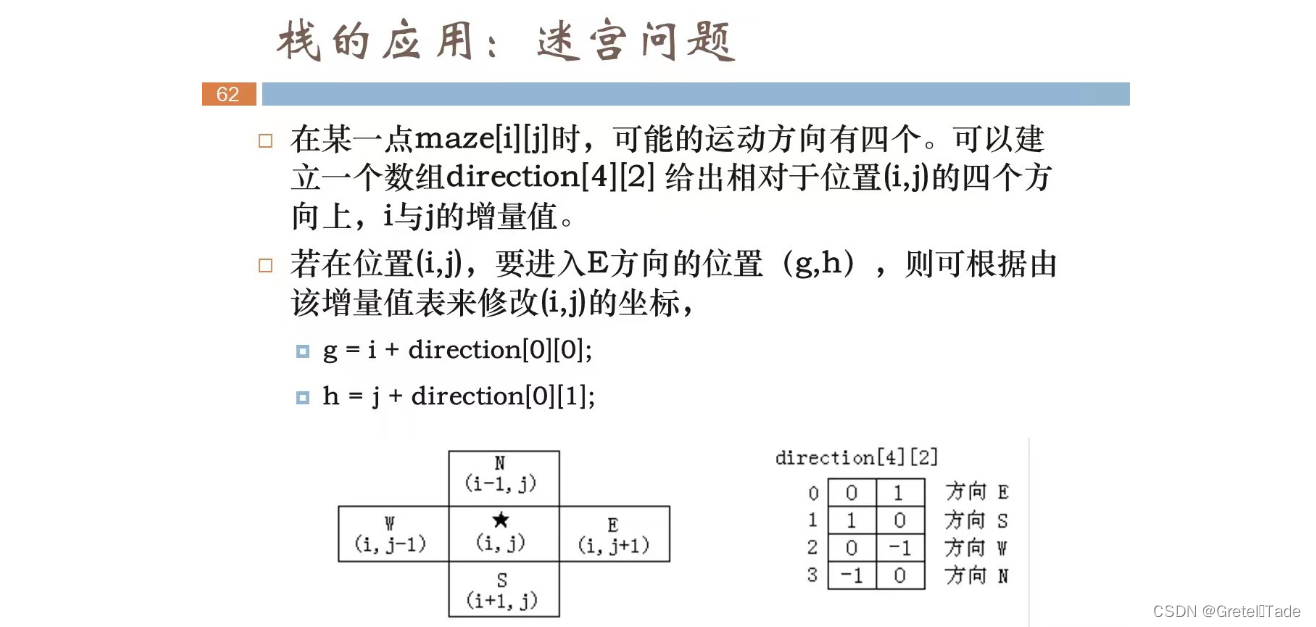
方向的储存结构:
//试探方向存储结构
typedef struct {
int xx, yy;
}Direction;
//东南西北
Direction dire[4] = { {0,1},{1,0},{0,-1},{-1,0} };代码实现
栈的cpp代码:
#include<stdio.h>
#include<stdlib.h>
//数据类型
typedef struct datatype {
int x, y, di;
}ElemType;
//节点
typedef struct node {
ElemType data;
struct node* next;
}Node;
//栈顶指示
typedef struct stack {
int count; //计数
Node* point;
}Stack;
//创建节点
Node* create_node(ElemType data) {
Node* new_node = (Node*)malloc(sizeof(Node));
if (new_node) {
new_node->data = data;
new_node->next = NULL;
return new_node;
}
else
{
printf("ERROR\n");
}
}
//初始化
void stack_init(Stack* top) {
top->count = 0;
top->point = NULL;
}
int isEmpty(Stack* top) {
if (top->count == 0) {
return 1;
}
return 0;
}
//入栈
void push(Stack* top, ElemType data) {
Node* new_node = create_node(data);
if (new_node) {
top->count++;
if (top->count == 1) {//如果入栈是第一个节点的话
top->point = new_node;
}
else
{
new_node->next = top->point;
top->point = new_node;
}
}
else
return;
}
//出栈
Node* pop(Stack* top) {
Node* pop_node = NULL;
if (!isEmpty(top)) {
pop_node = top->point;
top->point = pop_node->next;
top->count--;
}
return pop_node;
}
//递归输出路径
void show_path(Node* node) {
if (!node)
return;
show_path(node->next);
printf("(%d,%d)\n", node->data.x, node->data.y);
}栈的头文件h代码:
#pragma once
//链表栈
//数据类型
typedef struct datatype {
int x, y, di;
}ElemType;
//节点
typedef struct node {
ElemType data;
struct node* next;
}Node;
//栈顶指示
typedef struct stack {
int count; //计数
Node* point;
}Stack;
void stack_init(Stack* top);
int isEmpty(Stack* top);
void push(Stack* top, ElemType data);
Node* pop(Stack* top);
void show_path(Node* node);走迷宫代码:
#include<stdio.h>
#include<assert.h>
#include"stack.h"
//试探方向存储结构
typedef struct {
int xx, yy;
}Direction;
//东南西北
Direction dire[4] = { {0,1},{1,0},{0,-1},{-1,0} };
//判断能不能走出去,路径放入到了栈里面去
bool Findpath(int maze[][6],Stack* stack ,Direction dir[],int startx,int starty,int endx,int endy) {
//startx,starty是起点的坐标;endx、endy是终点的坐标.
assert(stack);
int x, y, di;
int line, col;
//初始化
maze[startx][starty] = -1;
ElemType start = { startx,starty,-1 };
push(stack, start);
while (!isEmpty(stack)) {
Node* po = pop(stack);
ElemType temp = po->data;
x = temp.x;
y = temp.y;
di = temp.di++;
//使得栈储存了一条通路
while (di < 4) {
line = x + dire[di].xx;
col = y + dire[di].yy;
if (maze[line][col] == 0) {
//储存上一个节点的位置,入栈
temp = { x,y,di };
push(stack, temp);
x = line;
y = col;
maze[line][col] = -1;
if (x == endx && y == endy) {
//把终点的位置入栈
temp = { x,y,-1 };
push(stack, temp);
return true;
}
else
di = 0;
}
else
di++;
}
}
return false;
}
int main() {
int maze[6][6] = {
{1,1,1,1,1,1},
{1,0,0,1,1,1},
{1,0,0,0,0,0},
{1,0,1,1,1,0},
{1,0,0,0,0,1},
{1,1,1,1,1,1}
};
Stack stack;
stack_init(&stack);
printf("能否出去:%d\n", Findpath(maze, &stack, dire, 1, 1, 4, 4));
show_path(stack.point);//输出遍历的结果
}输出结果:
好了,以上就是本期的全部内容了,我们下次见咯!
分享一张壁纸: 